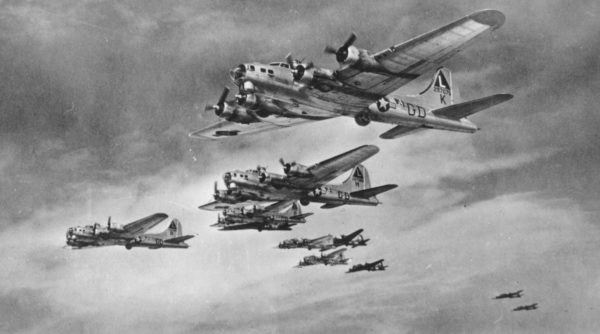The story of World War II airmen
Marvin Dille and William Meehan
Part 1 of 2
(Publisher’s note: Part 2 of Iowa History Journal’s two-part story about World War II bombardier Marvin Dille and navigator William Meehan will appear in our July/August issue.)

B-17 Flying Fortresses of the 381st Bombardment Group fly in formation. Courtesy of George J. Letter and American Air Museum in Britain/Imperial War Museums
By Matthew Walsh
A moonlit night had not yet given way to dawn on Jan. 4, 1944, when six United States Army Air Corps B-17s took flight from Ridgewell airfield in Essex, England, at 7:40 a.m. That day’s clear sky demanded the 381st Bombardment Group take aim at Germany once more.
The routine start to the mission would soon give way to the chaos of combat when one B-17 burst into flames. Among the crew was Iowa’s 1st Lt. Marvin E. Dille, a bombardier from Belle Plaine.
With its left wing ablaze, the B-17’s pilot and co-pilot veered out of formation. Over the radio, a distraught flier stated that he could not maintain the plane’s altitude. The Flying Fortress — a model manufactured by Boeing that had become a symbol of U.S. strength during World War II — would go down. The bomb load was ejected before flames reached the bomb-bay and blew the men to pieces. Pilots maneuvered their wheels and pedals, attempting to regain control of the falling aircraft. Dille and the rest of the terror-filled crew hoped they would somehow live another day so that their loved ones would not receive one of those dreaded telegrams from the U.S. Secretary of War.
In early March 1944, conversely, former Des Moines residents Edward and Ruth Meehan received the following message from Western Union: “The Secretary of War desires me to express his deep regret that your son Second Lieutenant William R. Meehan has been reported missing in action since 20 February on mission to Germany. If further details or other information are received you will be promptly notified.”
Their minds raced with questions. Their son had last been seen over a target in Leipzig, Germany, his B-17 in flames, losing altitude, chased by German fighters. Fellow airmen did not observe any parachutes, and some of those debriefed witnessed the plane explode.
Would Dille and Meehan make it back to Iowa? Or would they be among the 26,000 U.S. airmen who died during World War II?
TO READ THE ENTIRE STORY AND OTHER FASCINATING STORIES ABOUT IOWA HISTORY, subscribe to Iowa History Journal. You can also purchase back issues at the store.
